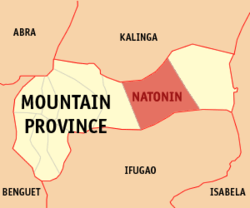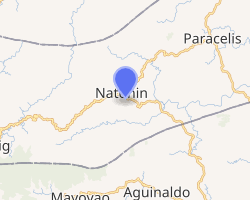Natonin
Natonin, officially the Municipality of Natonin is a 4th class municipality in the province of Mountain Province, Philippines. According to the 2015 census, it has a population of 10,272 people.[3]
Natonin | |
|---|---|
| Municipality of Natonin | |
 Seal | |
 Map of Mountain Province with Natonin highlighted | |
OpenStreetMap 
| |
.svg.png) Natonin Location within the Philippines | |
| Coordinates: 17°06′N 121°17′E | |
| Country | |
| Region | Cordillera Administrative Region (CAR) |
| Province | Mountain Province |
| District | Lone District |
| Founded | 1915 |
| Barangays | 11 (see Barangays) |
| Government | |
| • Type | Sangguniang Bayan |
| • Mayor | Jose T. Agagon |
| • Vice Mayor | Christopher M. Bayowan |
| • Congressman | Maximo Y. Dalog Jr. |
| • Electorate | 8,049 voters (2019) |
| Area | |
| • Total | 252.00 km2 (97.30 sq mi) |
| Population (2015 census)[3] | |
| • Total | 10,272 |
| • Density | 41/km2 (110/sq mi) |
| • Households | 2,187 |
| Economy | |
| • Income class | 4th municipal income class |
| • Poverty incidence | 35.67% (2015)[4] |
| • Revenue (₱) | 72,218,573.65 (2016) |
| Time zone | UTC+8 (PST) |
| ZIP code | 2624 |
| PSGC | |
| IDD : area code | +63 (0)74 |
| Climate type | tropical rainforest climate |
| Native languages | Balangao Bontoc Ilocano Tagalog |
Geography
The municipality is very mountainous, with very little level ground lending itself to agriculture. The barangays are geographically isolated by high (700m) mountains covered in jungle. It has a total land area of around 20 000 hectares.
Barangays
Natonin is politically subdivided into 11 barangays.
- Alunogan
- Balangao
- Banao
- Banawel
- Butac
- Maducayan
- Poblacion
- Saliok
- Santa Isabel
- Tonglayan
- Pudo
Climate
| Climate data for Natonin, Mountain Province | |||||||||||||
|---|---|---|---|---|---|---|---|---|---|---|---|---|---|
| Month | Jan | Feb | Mar | Apr | May | Jun | Jul | Aug | Sep | Oct | Nov | Dec | Year |
| Average high °C (°F) | 20 (68) |
21 (70) |
23 (73) |
26 (79) |
26 (79) |
26 (79) |
25 (77) |
25 (77) |
24 (75) |
23 (73) |
22 (72) |
20 (68) |
23 (74) |
| Average low °C (°F) | 14 (57) |
15 (59) |
16 (61) |
17 (63) |
18 (64) |
18 (64) |
18 (64) |
18 (64) |
18 (64) |
18 (64) |
17 (63) |
16 (61) |
17 (62) |
| Average precipitation mm (inches) | 103 (4.1) |
73 (2.9) |
49 (1.9) |
38 (1.5) |
141 (5.6) |
144 (5.7) |
172 (6.8) |
181 (7.1) |
155 (6.1) |
148 (5.8) |
147 (5.8) |
208 (8.2) |
1,559 (61.5) |
| Average rainy days | 17.1 | 12.8 | 11.0 | 9.6 | 18.9 | 21.5 | 23.5 | 24.5 | 21.7 | 16.1 | 17.1 | 20.5 | 214.3 |
| Source: Meteoblue [5] | |||||||||||||
Demographics
|
| |||||||||||||||||||||||||||||||||||||||||||||
| Source: Philippine Statistics Authority[3][6][7][8] | ||||||||||||||||||||||||||||||||||||||||||||||
The natives of the town are generally called Balangaos/ Iferangao who speak the Finerangao language. There are two sub-tribes namely Hakki who inhabit the western part of the town and the Majukayyongs who inhabit the Barangays of Saliok and Maducayan. The Majukayyongs initially came from Southern Kalinga. Populations of the town are of Igorot lineage. Headhunting was practiced in throughout Natonin as late as the mid-1930s, and was set aside in favor of Christianity and education after World War II.
Languages
The town is home to two indigenous languages which have been existing in the town even before the arrival of the Spanish. These languages are the "Balangaw" dialect and the "Kinalinga" dialect. Immigrants from the Ilocos Region came in the 1970's and imported the "Ilokano" dialect during the martial law era.
Economy
The primary crop is rice, although a lack of arable land, lack of mechanization and no access to fertilizers limits the harvest to a subsistence level only. Families rely on small livestock populations to supplement the diet. Fruits and wild coffee are harvested from the forest. Poblacion boasts of numerous family ponds which raise tilapia for consumption. Due to the terrain, rice is planted on terraced fields. Locals consider the rice terraces of Natonin to be equal or surpassing those of Banaue to the south.
Transportation
Transportation throughout Natonin is largely undeveloped roads. The only paved roads (as of 2007) are in Poblacion proper. Roads frequently become impassable in the rainy seasons. Some barangays (notably Maducayan) are inaccessible by road. Maducayan lies one mile beyond a recent road extension from the center of Saliok to the westernmost situ of Saliok.
Tourism
Natonin have the following tourism sites:
- The Legendary Silent Mountain of Binaratan - located in Barangay Maducayan.
- The Apatan Rice Terraces
- The Balococ Waterfall
- The Naropaan Waterfall
- Tongalayan Rice Terraces
- Lagan river in Balangao
- Penadna Waterfalls
- Lettalet Waterfalls
References
- "Municipality". Quezon City, Philippines: Department of the Interior and Local Government. Retrieved 31 May 2013.
- "Province: Mountain Province". PSGC Interactive. Quezon City, Philippines: Philippine Statistics Authority. Retrieved 12 November 2016.
- Census of Population (2015). "Cordillera Administrative Region (CAR)". Total Population by Province, City, Municipality and Barangay. PSA. Retrieved 20 June 2016.
- "PSA releases the 2015 Municipal and City Level Poverty Estimates". Quezon City, Philippines. Retrieved 12 October 2019.
- "Natonin: Average Temperatures and Rainfall". Meteoblue. Retrieved 8 March 2020.
- Census of Population and Housing (2010). "Cordillera Administrative Region (CAR)". Total Population by Province, City, Municipality and Barangay. NSO. Retrieved 29 June 2016.
- Censuses of Population (1903–2007). "Cordillera Administrative Region (CAR)". Table 1. Population Enumerated in Various Censuses by Province/Highly Urbanized City: 1903 to 2007. NSO.
- "Province of Mountain Province". Municipality Population Data. Local Water Utilities Administration Research Division. Retrieved 17 December 2016.